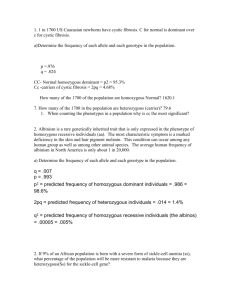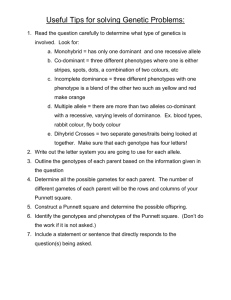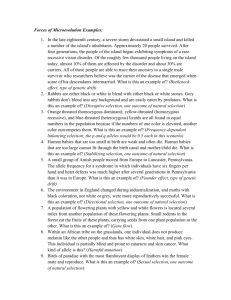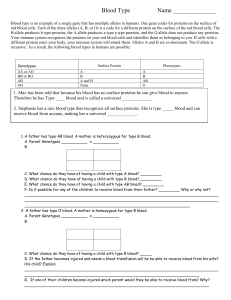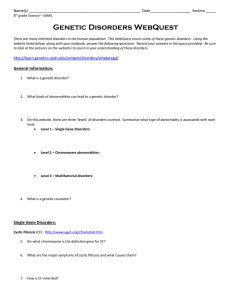Case Study #2
advertisement
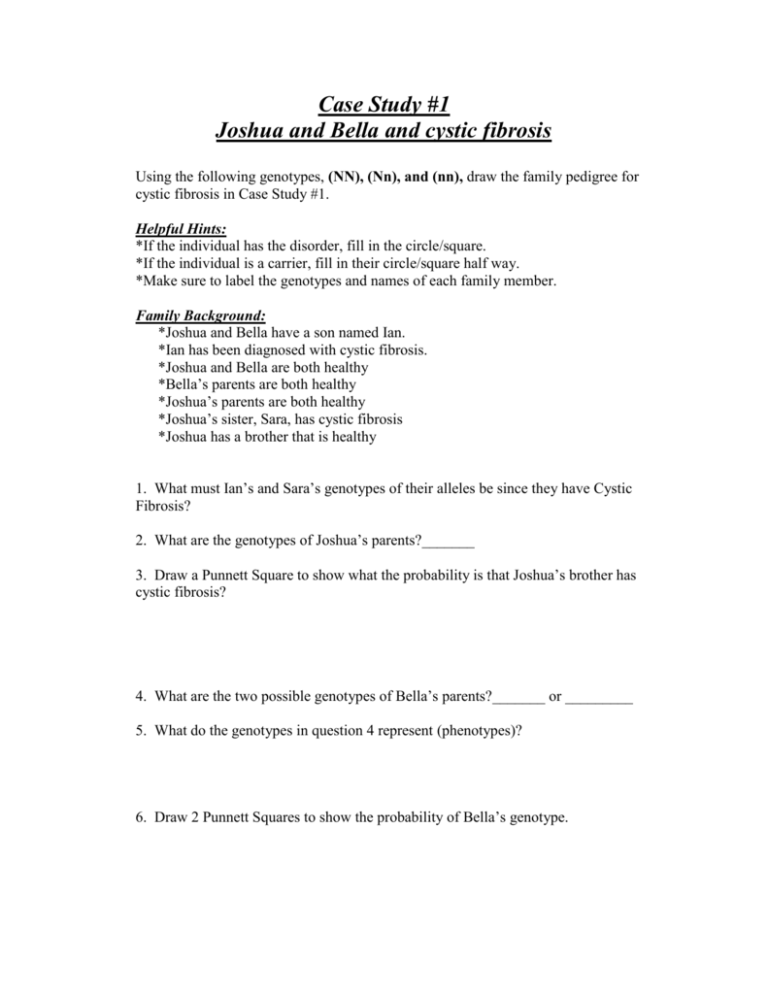
Case Study #1 Joshua and Bella and cystic fibrosis Using the following genotypes, (NN), (Nn), and (nn), draw the family pedigree for cystic fibrosis in Case Study #1. Helpful Hints: *If the individual has the disorder, fill in the circle/square. *If the individual is a carrier, fill in their circle/square half way. *Make sure to label the genotypes and names of each family member. Family Background: *Joshua and Bella have a son named Ian. *Ian has been diagnosed with cystic fibrosis. *Joshua and Bella are both healthy *Bella’s parents are both healthy *Joshua’s parents are both healthy *Joshua’s sister, Sara, has cystic fibrosis *Joshua has a brother that is healthy 1. What must Ian’s and Sara’s genotypes of their alleles be since they have Cystic Fibrosis? 2. What are the genotypes of Joshua’s parents?_______ 3. Draw a Punnett Square to show what the probability is that Joshua’s brother has cystic fibrosis? 4. What are the two possible genotypes of Bella’s parents?_______ or _________ 5. What do the genotypes in question 4 represent (phenotypes)? 6. Draw 2 Punnett Squares to show the probability of Bella’s genotype. Case Study #2: Li and Mai and a skin condition Using the following genotypes, (TT), (Tt), and (tt), draw a family pedigree for the skin condition in Case Study #2. Write in (tt) next to the individuals with the skin condition. Helpful Hints: *If the individual has the disorder, fill in the circle/square. *If the individual is a carrier, fill in their circle/square half way. *Make sure to label the genotypes and names of each family member. Family Background: *The father, Li, has a skin condition. The mother, Mai, has normal skin. *Li and Mai’s first child, a girl named Gemma, has the same condition as Li. *Mai’s sister has a similar skin condition, but Mai’s parents do not. *Li has one brother whose skin is normal, and one sister who has the skin condition. *Li’s mother has the skin condition. His father does not. *Li’s family lives in a heavily wooded area. His family has always thought the skin condition was a type of allergy. 1. Would you predict that the skin condition is most likely inherited from a recessive allele? 2. What is the genotype of Li’s parents? __________ 3. Draw a punnett square showing that Li’s brother does not have the skin condition. 4. What is the genotype of Mai’s parents?_________ 5. Draw a Punnett Square showing how Mai does not have the skin condition. 6. This concludes that Mai must be a ______________ for the skin disorder. 7. Draw a Punnett Square to show what the probability is that Mai and Li’s next child would have the skin condition. Case Study #1 Answers 1. What must Ian’s and Sara’s genotypes of alleles be since they have cystic fibrosis? Their alleles are nn. 2. What are the genotypes of Joshua’s parents? Joshua’s parents are both heterozygous (Nn). What are the genotypes of Bella’s parents? The genotypes of Bella’s parents cannot be determined for certain, but one must be heterozygous (Nn) and the other could be heterozygous (Nn) or homozygous (NN). 3. What is the probability that Joshua’s brother has cystic fibrosis? Because both parents are heterozygous (Nn), there is a 25% chance of each child inheriting two “n” alleles and having cystic fibrosis. Case Study #2 Answers 1. Would you predict that the skin condition is most likely inherited from a recessive allele? All of the evidence in the family’s pedigree supports the conclusion that the skin condition is controlled by a recessive allele. At least one of Mia’s parents would have the skin condition if the allele were dominant, but both of the parents have normal skin. 2. What is the probability that Mai’s and Li’s next child would have the skin condition? Because one of the parents were heterozygous (Ss) and one was homozygous (ss) for the skin condition, there is a 50% chance of each child inheriting two s alleles and having the skin condition. 3. Genetic counselors cannot usually draw firm conclusion about the hereditary condition with information about just one or two generations, because more than one inheritance pattern may explain the facts when the information is so limited.


